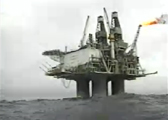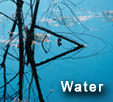Hibernia Drill Wastes

Streaming Video - High resolution | Low resolution | RealPlayer Help
Summary
Boom times are around the corner for Eastern Canada's offshore oil and gas industry. The massive Hibernia platform off Newfoundland leads a handful of projects. But with economic promise comes environmental concern. Fisheries and Oceans researchers are looking into the effects of the release of the drilling mud in the area surrounding the platform. They are measuring the impact zone by studying scallops. Work in the laboratory suggests that they are a good indicator species. So Bedford Institute of Oceanography scientists are taking the high seas to test their hypothesis.
Transcript of Video
Jill Deacon
Well, it looks as though boom times are on the way for Eastern Canada's offshore oil and gas industry. The massive Hibernia platform, off Newfoundland, is just one of many projects in the works. Many more are on the way. But along with economic promise... comes environmental concern. Canadian researchers are especially worried about what those rigs are putting back into the ocean... And they're relying on some of Hibernia's smallest neighbours to tell them the truth.
Jay Ingram
Hibernia rises out of the Atlantic mist. Tons of metal and concrete tower over the Grand Banks. It's an imposing monument to technology... and the economic hope of a region.
Dr. Peter Cranford
There's a lot of potential on our offshore. Right now, we have... uh... Hibernia is our largest project. There's numerous new reservoirs that are coming on-line, and so we're really at this stage of expansion.
Jay Ingram
But what is it like to live next door to an oil rig?
Dr. Cranford
It was initially thought that impacts on the animals who live on the sea bed around the platform were very localized... but as more research has been done, they're seeing that this impact zone is expanding all the time. And perhaps some of the most recent work shows that impacts could be up to about 100 square kilometres.
Jay Ingram
Dr. Cranford wants to test those outer limits. He's measuring the impact zones by studying scallops. They are perfectly suited for the job. Scallops are filter-feeders... they ingest fine particles in the water... even if those particles include pollutants from an oil well.
Dr. Cranford
Our work in the lab says they're very good indicator species... very good sentinel species for monitoring impacts... because of their sensitivity... They're a clear water species... they like very clear, pristine conditions so when you start adding some pollutants, some contaminant... to the water, they react quite dramatically.
Jay Ingram
They're extremely sensitive to drilling wastes... especially the "gunk" that greases the drill bit. This is a man-made concoction the industry calls "MUD."
This is usually a key component of mud... a fine, heavy clay powder called Berite.
Dr. Cranford
... and in this case you see an oil based mud, with the oil on the top, and the... the berite on the bottom. This would be shaken up so that it forms a very thick mud.
Jay Ingram
Existing regulations allow some used mud to be dumped into the ocean. Berite and oil cling to the drill cuttings... and they're dumped overboard. This chemical soup ends on the ocean floor, home to the scallops. Tests at the Bedford Institute of Oceanography show that exposure to even small amounts of berite particles caused scallops to stop feeding.
Dr. Cranford
They were highly susceptible... and what was going on was... the animals' growth rates were being reduced and sometimes completely stopped by the drilling waste. Their reproduction was very sensitive to it... so that the animals really weren't even reproducing at very low concentrations of drilling muds.
Jay Ingram
Dr. Cranford wondered if the scallops could act like canaries in coal mines. He thinks shellfish could be used to monitor the level of drilling wastes in the ocean.
But before he could verify that idea, he and his colleagues had to design and build testing equipment that would withstand the rigours of the North Atlantic.
Dr. Cranford
It's a very harsh environment we're working in... the bottom temperature at Hibernia is about one degree year round. So we've got batteries and electronics that have to work under these conditions, plus, off shore, on large ships... you know, it can be very rough on gear.
Jay Ingram
Finally, with the gear stowed, and tanks full of shellfish, the research vessel Hudson set sail for Hibernia.
At sea the decks of the Hudson look more like a construction site than a research vessel. First overboard were Dr. Cranford's Habitraps. The large, funnel shaped devices measure scallop feeding rates, in the wild... testing for subtle effects from drilling waste.
At the last minute... Dr. Cranford places the scallops into the top of the trap... The Habitraps collect scallop feces... scientists figure if they know what's coming out... they've got a pretty good idea of what's going in.
Six Habitraps were deployed, at distances up to six kilometres from Hibernia. This was the second test... The Harp is a cage for shellfish. Scallops and mussels are painstakingly tied and strung to the frames... Once lowered overboard, they'll have a summer to feed at sea... and when recovered, they're sampled and analyzed for drilling wastes, and their growth is then compared to shellfish that were placed far away from the drill rig.
Dr. Peter Cranford
These instruments were deployed... some of them for very short periods of time to see how the animals were responding to really rapid changes in the environment... And there were other instruments that we deployed over longer periods... so the two sampling programs basically would tell us what types of events would cause impacts on animal.
Jay Ingram
The results, once tabulated, will help researchers determine the effects of drilling wastes on marine life. They'll also help regulators rewrite the rules for the disposal of drilling wastes.
But there is another benefit. Dr. Cranford plans to modify the traps so industries can use shellfish to help them to keep track of their own environmental footprints.
Dr. Cranford
Outside of the oil and gas monitoring examples, you could tailor it towards pulp and paper mill effluents and environmental impacts. It could be used for looking at impacts of aquaculture, impacts of mining... so that there are a number of uses that... It wouldn't require very much modification to be used in those situations.
Jay Ingram
Next summer's plans are already in the works. Dr. Cranford and his team will head back to Hibernia. They'll be refining their experiments... and tweaking the equipment, and looking to some of the ocean's smallest and most valuable commercial species... to keep a neighbourhood watch.
Jill Deacon
Tonight's Earth Tones was produced with the help of the Department of Fisheries and Oceans.






